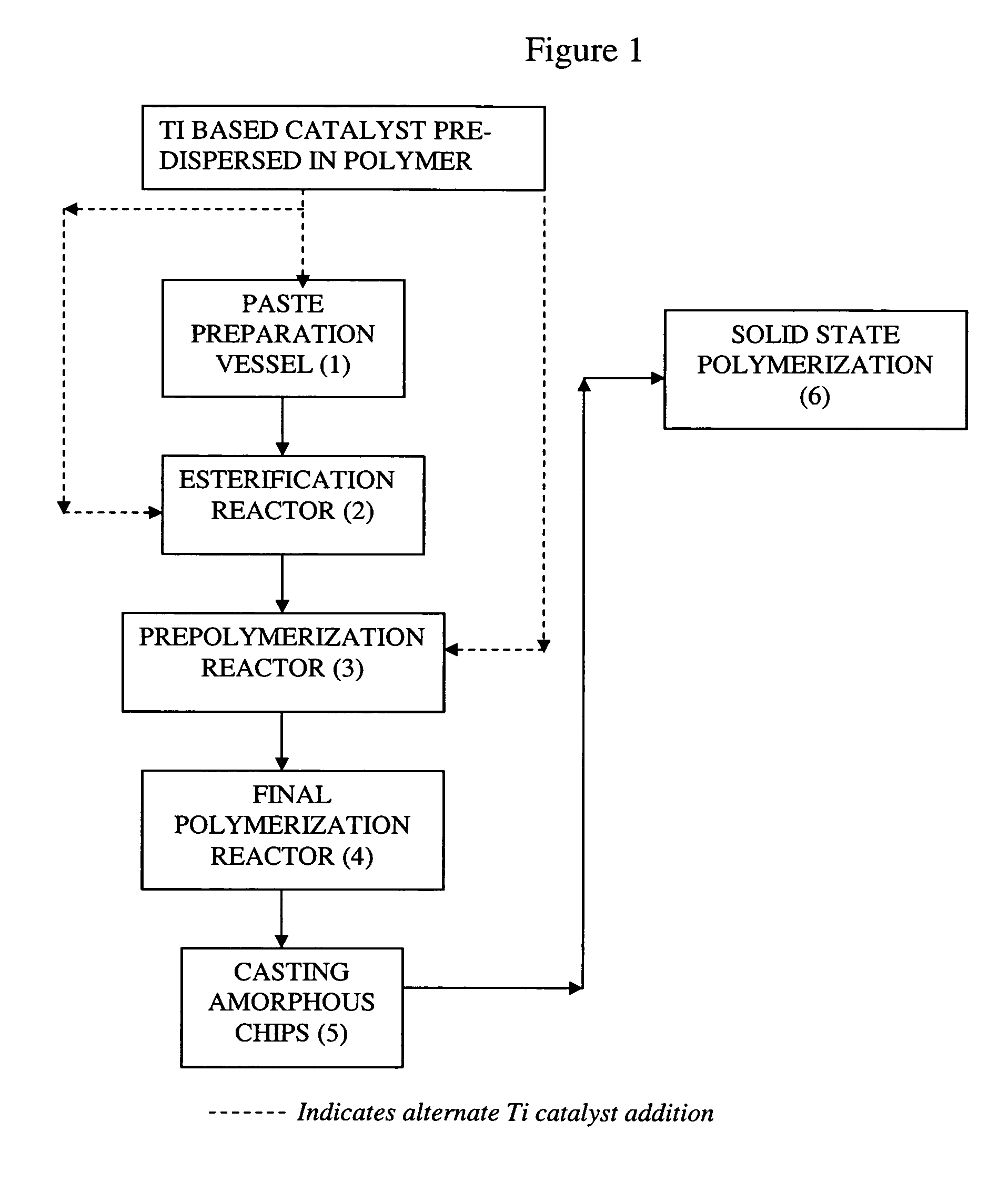Process for the preparation of polyethylene terephthalate (PET)
a technology of polyethylene terephthalate and polyethylene terephthalate, which is applied in the field of process for the preparation of polyethylene terephthalate (pet), can solve the problems of limited use of the substance, and achieve the effect of good thermal stability
- Summary
- Abstract
- Description
- Claims
- Application Information
AI Technical Summary
Benefits of technology
Problems solved by technology
Method used
Image
Examples
example 1
[0040]Slurry of 10.16 kg of pure terepthalic acid (PTA) along with 0.24 kg of isopthalic acid (IPA) are reacted together with 4 litres of monoethylene glycol (MEG) and prepared as a paste in a paste preparation vessel. A master batch of 0.1–5% of Potassium Titanium Oxide Oxalate pre-dispersed in a PET Polymer matrix is prepared. The quantity of Ti complex present as a master batch is used is in the range of 5–40 ppm as Titanium in this example. Suitable quantities of antimony compound (in the range of 100–310 ppm) are added wherever necessary. The time of addition of this Ti catalyst and / or antimony is varied to observe its effect on the color of the polymer. Cobalt Acetate in the range of 20–70 ppm, is added in the paste preparation vessel along with PTA / MEG. Different levels of Cobalt acetate are used to improve the color in the absence of colour toners. Esterifying the slurry in a reduced time period of 200 minutes, followed by controlled degree of polymerisation between 5 and 10...
example 2
[0044]This example adopts the process steps of Example 1. But in addition to the cobalt compound, red and blue toners are used in the range of 1.5–2.0 ppm for improving the color. In the present example antimony based catalyst is totally replaced by Ti complex catalyst in the range of 20–95 ppm as titanium, pre-dispersed in PET polymer matrix. The results as obtained by executing process steps of Example 2 are tabulated in Tables 2.
[0045]
TABLE 2Properties of Amorphous Polymer based on Example 2ADDITIVES LEVELSPPMPOLYMER PROPERTIESEG.TiAdditionCoHSI.V.No.ppmmodeppmTppmE TP.P.TP.E.Tdl / gL*b*H120Initial—1.536162–2662872810.6076.1−2.14220Initial101.554″″″0.6172.9−2.83.9320After101.554″″″0.6273.5−0.054.6esterifi-cation425Initial20254″″″0.6068−7.24.2535Initial15254″″″0.6269−1.67.2695Initial40—25″″″0.6171.7−7.83.7L* b* are Commission Internationale de l'eclairage of France (CIE) values CIE values.T—TonersHS—Heat StabilizersE T—Esterification TemperatureP.P.T—Peak Poly TemperatureP.E.T—Poly ...
example 3
[0047]The process steps as disclosed in Example 1 are repeated and the amorphous polymer obtained with Ti compound catalyst is Solid State Polymerized (SSP) and the Intrinsic Viscosity I.V increase with time is compared with normal antimony catalysed processes.
[0048]Even though Ti compound catalyst shows an improvement in color and melts processing times, it results in marginal to significant drop in the SSP rate depending upon the replacement of antimony and the introduction of titanium and cobalt levels. The SSP rate reduction is in the range 6–26%. The details of the results are tabulated in Table 3 for Amorphous Polymer and the results of SSP are tabulated in Table 4.
[0049]
TABLE 3Properties of Amorphous Polymer based on Example 3ADDITIVES LEVELSPPMPOLYMER PROPERTIESEG.SbTiCoI.V.No.ppmppmppm‘P’ ppmP.C.TDl / gL*b*H11001530492350.58571.1−6.36.72300—60542060.61971.9−6.813.13—2590543380.59570.6−9.34.24—3060542130.61868.1−9.32.95—4040362400.61066.6−6.24.0L* b* are Commission Internation...
PUM
| Property | Measurement | Unit |
|---|---|---|
| temperature | aaaaa | aaaaa |
| particle size | aaaaa | aaaaa |
| temperature | aaaaa | aaaaa |
Abstract
Description
Claims
Application Information
 Login to View More
Login to View More - R&D
- Intellectual Property
- Life Sciences
- Materials
- Tech Scout
- Unparalleled Data Quality
- Higher Quality Content
- 60% Fewer Hallucinations
Browse by: Latest US Patents, China's latest patents, Technical Efficacy Thesaurus, Application Domain, Technology Topic, Popular Technical Reports.
© 2025 PatSnap. All rights reserved.Legal|Privacy policy|Modern Slavery Act Transparency Statement|Sitemap|About US| Contact US: help@patsnap.com

